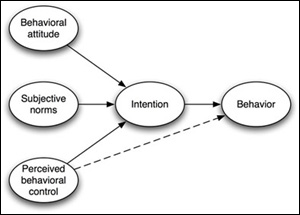|
|

|
Ψ Behavior & Attitudes
|

|
|
How well do our attitudes predict our behavior?
Ψ An attitude is a favorable or unfavorable evaluative reaction toward something or someone, exhibited in one's beliefs, feelings, or intended
behavior.
Ψ Attitudes are judgments. They develop on the ABC model (affect, behavior, & cognition). The affective response is an emotional response that expresses an individual's degree of preference for an entity. The behavioral intention is a verbal indication or typical behavioral tendency of an individual. The cognitive response is a cognitive evaluation of the entity that constitutes an individual's beliefs about the object.
Ψ Attitudes predict behavior when
• social influences on what we say are minimal.
- The Implicit Association Test (IAT) is an experimental method within social psychology designed
to measure the strength of automatic association between mental representations of objects
(concepts) in memory. The IAT requires the rapid categorization of various stimulus objects, such
that easier pairings (& faster responses) are interpreted as being more strongly associated in
memory than more difficult pairings (slower responses). The greater the association the greater
the social influence is.
• other influences on behavior are minimal.
• attitudes specific to the behavior are examined.
- The theory of planned behavior assumes that rational considerations govern the choices &
behaviors of individuals (Ajzen, 1985; Ajzen, 1991; Ajzen & Fishbein, 2005). Specifically, according
to a precursor of this theory, called the theory of reasoned action, behavior is determined by the
intentions of individuals--their explicit plans or motivations to commit a specific act.

• attitudes are potent.
When Does Behavior Determine Attitudes?
Ψ Behavior determines attitudes when
• role playing. Role playing refers to the changing of one's
behavior to assume a role, either unconsciously to fill a social role, or consciously to act out an adopted role.
• saying becomes believing.
• exposed to the Foot-In-The-Door Phenomenon - asking for a small commitment & after gaining compliance, asking for a bigger commitment.
- exposed to the lowball technique - getting a commitment from a person & then rising the cost of that commitment.
Ψ Actions affect our moral attitudes.
- That which we have done, even if evil, we tend to justify as right.
- We tend not only to hurt those we dislike but also to
dislike those we hurt.
Ψ Interracial Behavior & Racial Attitudes
- Laws change behavior (desegregation), which changes attitudes.
- Social Movements, Flag salutes, demonstrations, & other behaviors influence attitudes.
Ψ Brainwashing, the term used to describe what happened to American prisoners during the Korean War is a potent form of social indoctrination that uses many of the techniques described above.
Why does our behavior affect our attitudes?
Ψ Self-presentation Theory (Impression Management)
Ψ Self-presentation: refers to our wanting to present a favorable image both to an external audience (others) & to an internal audience (ourselves).
Ψ Impression Management is a goal-directed conscious or unconscious process in which people attempt to influence the perceptions of other people about a person, object or event; they do so by regulating & controlling information in social interaction). It is usually used synonymously with self-presentation, in which a person tries to influence the perception of their image. The notion of impression management also refers to practices in professional communication
& public relations, where the term is used to describe the process of formation of a company's or organization's public image.
Ψ Self-justification (Cognitive Dissonance Theory)
- According to cognitive dissonance theory (L. Festinger), there is a tendency for individuals to seek consistency among their cognitions (i.e., beliefs, opinions). When there is an inconsistency between attitudes or behaviors (dissonance), something must change to eliminate the dissonance. In the case of a discrepancy between attitudes & behavior, it is most likely that the attitude will change to accommodate the behavior.
- Two factors affect the strength of the dissonance: the number of dissonant beliefs,
& the importance attached to each belief. There are three ways to eliminate dissonance: (1) reduce the importance of the dissonant beliefs, (2) add more consonant beliefs that outweigh the dissonant beliefs, or (3) change the dissonant beliefs so that they are no longer inconsistent.
- Dissonance occurs most often in situations where an individual must choose between two incompatible beliefs or actions. The greatest dissonance is created when the two alternatives are equally attractive. Furthermore, attitude change is more likely in the direction of less incentive since this results in lower dissonance. In this respect, dissonance theory is
contradictory to most behavioral theories which would predict greater attitude change with increased incentive (i.e., reinforcement).
- Insufficient Justification: The phenomena of experiencing a belief change when forced to act against one's beliefs with low external justification.
- Dissonance After Decisions: Dissonance is reduced. Attitudes change to support the decision that was made.
Ψ Self-perception Theory
- Self-perception theory (SPT) is an account of attitude change developed by psychologist Daryl Bem. It asserts that people develop their attitudes by observing their behavior & concluding what attitudes must have caused them. The theory is counterintuitive in nature, as the conventional wisdom is that attitudes come prior to behaviors. Furthermore, the theory suggests that a person induces attitudes without accessing internal cognition & mood states. The person reasons their own overt behaviors rationally in the same way they attempt to explain others behaviors. They self monitor.
- The self-perception theory was initially proposed as an alternative to explain the experimental findings of the cognitive dissonance theory, & there were debates as to whether people experience attitude changes as an effort to reduce dissonance or as a result of self-perception processes. Self-perception theory differs from the cognitive dissonance theory in that it does not hold that people experience a "negative drive state" called "dissonance" which they seek to relieve.
Ψ Expressions & Attitudes
- Our expressions (facial) influence our feelings.
- Our expressions (facial) influence our attitudes.
- Doing influences thinking.
Ψ Overjustification & Intrinsic Motivation
- The overjustification effect occurs when an external incentive such as money or
prizes decreases a person's intrinsic motivation to perform a task. According to
self-perception theory, people pay more attention to the incentive, & less attention
to the enjoyment and satisfaction that they receive from performing the activity.
The overall effect is a shift in motivation to extrinsic factors & the undermining of
pre-existing intrinsic motivation.
Overjustification effect. (2010, July 3). In Wikipedia, The Free Encyclopedia. Retrieved 15:46,
September 12, 2010, from http://en.wikipedia.org/w/index.php?
title=Overjustification_effect&oldid=371493096
Ψ Comparing the Theories
- Dissonance as Arousal - strongly supported by research
- Self-Affirmation Theory explains how people will reduce the impact of a threat to their self-concept by focusing on & affirming their competence in some other area. Self-affirmation studies suggested that discomfort resulting from cognitive dissonance can be overcome if self-integrity is enhanced through the affirmations of an alternative domain of identity.
- Dissonance theory explains what happens when we act contrary to clearly defined attitudes; tension leads to attitude change which restores mental equilibrium. When our attitudes are not well formed, self-perception theory explains attitude formation.
|

















